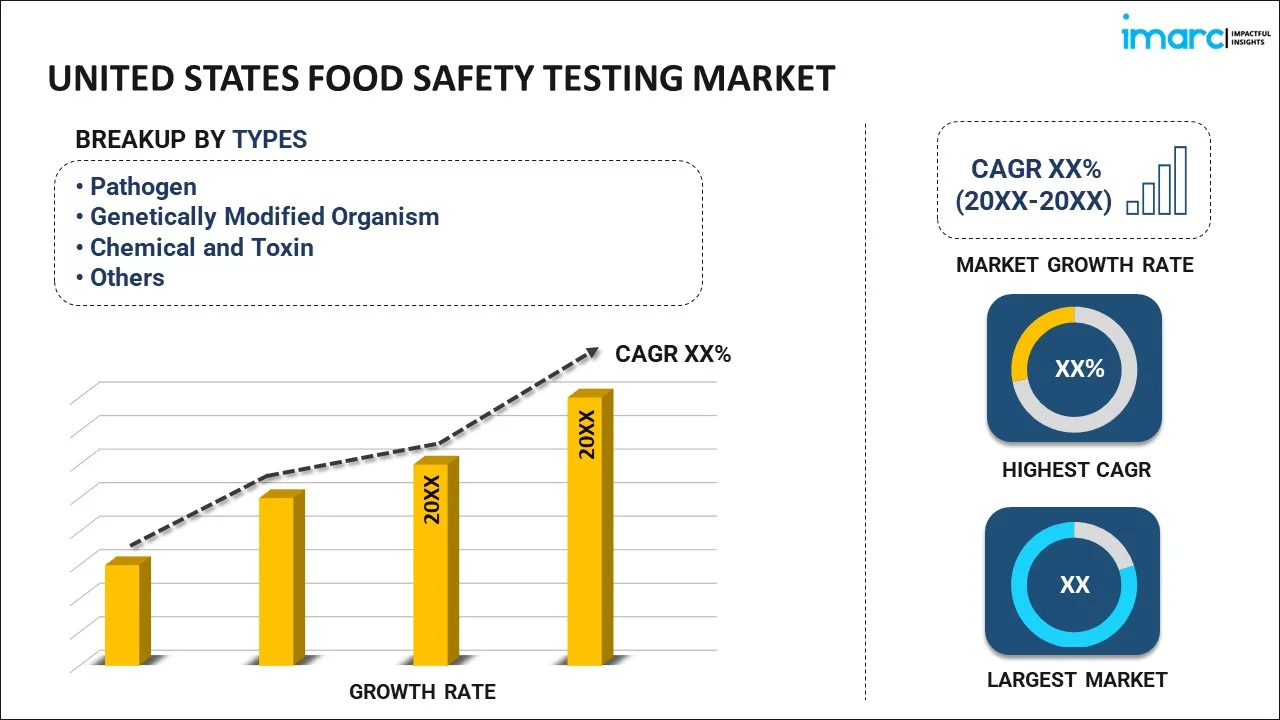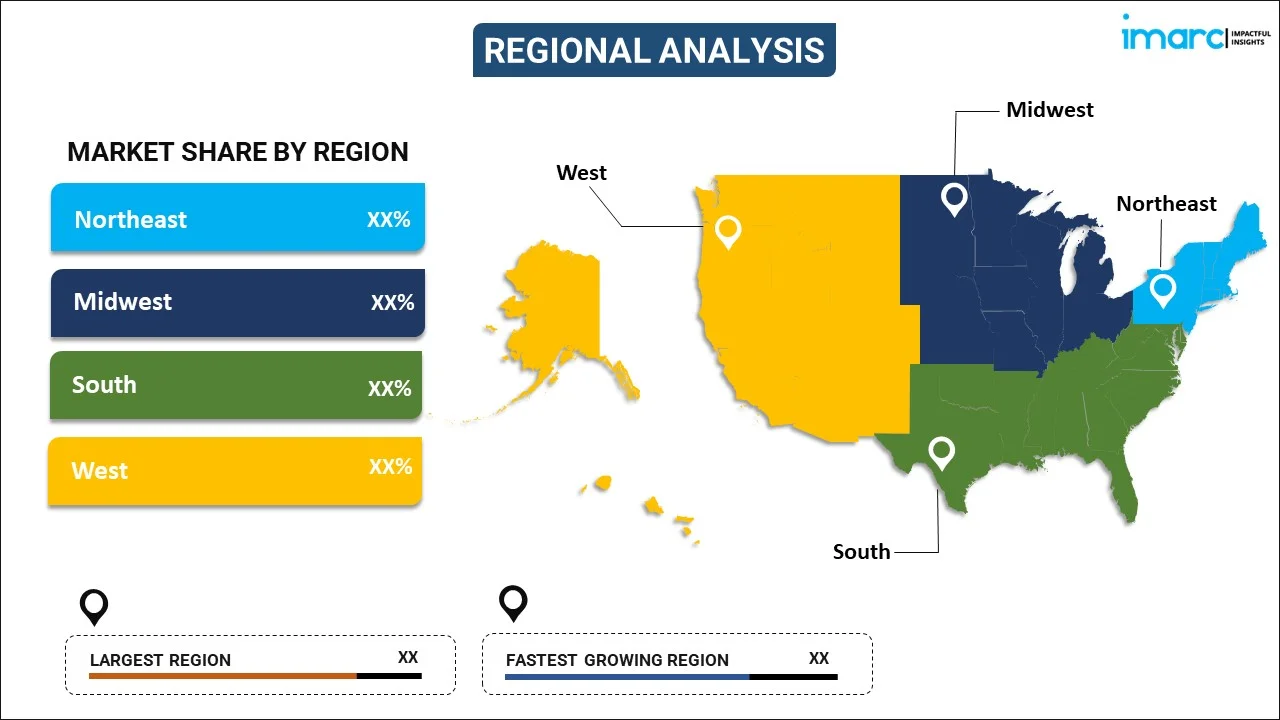
United States Food Safety Testing Market Report by Type (Pathogen, Genetically Modified Organism, Chemical and Toxin, and Others), Food Tested (Meat and Meat Products, Dairy and Dairy Products, Cereals, Grains and Pulses, Processed Food, and Others), Technology (Agar Culturing, PCR-based Assay, Immunoassay-based, and Others), and Region 2025-2033
Market Overview:
The United States food safety testing market size reached USD 6.1 Billion in 2024. Looking forward, IMARC Group expects the market to reach USD 12.3 Billion by 2033, exhibiting a growth rate (CAGR) of 8% during 2025-2033. The implementation of stringent regulatory standards, rising consumer awareness and demand for transparency in food production, the prevalence of foodborne illnesses, recent technological advancements, and the globalization of the food supply chain represent some of the key factors driving the market.
|
Report Attribute
|
Key Statistics
|
|---|---|
|
Base Year
|
2024 |
|
Forecast Years
|
2025-2033
|
|
Historical Years
|
2019-2024
|
| Market Size in 2024 | USD 6.1 Billion |
| Market Forecast in 2033 | USD 12.3 Billion |
| Market Growth Rate (2025-2033) | 8% |
Food safety testing refers to an essential process employed to ensure the safety and quality of food products. It includes a series of procedures aimed at detecting potentially harmful contaminants, such as pathogens, chemicals, and genetically modified organisms (GMOs), in food. Food safety testing includes microbiological analysis, chemical and toxin analysis, allergen testing, and GMO testing. It utilizes various technologies, such as culture media, chromatography, and polymerase chain reaction (PCR). Food safety testing is employed in various sectors like meat and poultry, dairy, processed foods, fruits and vegetables, and beverages. It offers consumer protection, compliance with regulatory standards, prevention of foodborne illnesses, quality assurance, and maintenance of brand reputation. Additionally, food safety testing provides several advantages, such as improved accuracy in contamination detection, rapid testing methods, and the ability to test a wide range of contaminants.
United States Food Safety Testing Market Trends:
The implementation of stringent regulatory standards by governments enforcing rigorous food safety regulations is one of the major factors boosting the market growth. Moreover, the rising consumer awareness and demand for transparency in food production, prompting food companies to adopt rigorous testing protocols, is creating a positive outlook for the market growth. Along with this, the widespread emergence of foodborne illnesses, encouraging the adoption of food safety testing, is providing a thrust to the market growth. Besides this, recent technological advancements and innovations, such as rapid testing technologies, PCR-based tests, and advanced chromatography that make food safety testing more accurate, faster, and cost-effective, are positively impacting the market growth. In line with this, rapid advancements facilitating the detection of contaminants at lower levels and expediting the testing process, enabling quicker response times to potential food safety issues, are anticipated to drive the market growth. Furthermore, the rising globalization of the food supply chain, necessitating robust testing protocols to maintain food safety standards, is fostering the market growth. Additionally, the sudden shift towards organic and natural food products, requiring specific testing to verify their organic status and the absence of prohibited substances, is propelling the market growth. In addition to this, the increasing research and development (R&D) initiatives focusing on discovering emerging contaminants, such as new strains of pathogens and chemical residues, are catalyzing the market growth. Apart from this, the implementation of big data and machine learning (ML) in food safety testing to enhance predictive analytics capabilities and allow more efficient risk assessment is supporting the market growth. Furthermore, the increasing partnerships and collaborations between government agencies, testing companies, and food producers to standardize testing procedures, share best practices, and foster innovation in food safety testing methodologies are creating remunerative growth opportunities for the market.
United States Food Safety Testing Market Segmentation:
IMARC Group provides an analysis of the key trends in each segment of the market, along with forecasts at the country level for 2025-2033. Our report has categorized the market based on type, food tested, and technology.
Type Insights:

- Pathogen
- Genetically Modified Organism
- Chemical and Toxin
- Others
The report has provided a detailed breakup and analysis of the market based on the type. This includes pathogen, genetically modified organism, chemical and toxin, and others.
Food Tested Insights:
- Meat and Meat Products
- Dairy and Dairy Products
- Cereals, Grains and Pulses
- Processed Food
- Others
A detailed breakup and analysis of the market based on the food tested have also been provided in the report. This includes meat and meat products, dairy and dairy products, cereals, grains and pulses, processed food, and others.
Technology Insights:
- Agar Culturing
- PCR-based Assay
- Immunoassay-based
- Others
The report has provided a detailed breakup and analysis of the market based on the technology. This includes agar culturing, PCR-based assay, immunoassay-based, and others.
Regional Insights:

- Northeast
- Midwest
- South
- West
The report has also provided a comprehensive analysis of all the major regional markets, which include the Northeast, Midwest, South, and West.
Competitive Landscape:
The market research report has also provided a comprehensive analysis of the competitive landscape in the market. Competitive analysis such as market structure, key player positioning, top winning strategies, competitive dashboard, and company evaluation quadrant has been covered in the report. Also, detailed profiles of all major companies have been provided.
United States Food Safety Testing Market Report Coverage:
| Report Features | Details |
|---|---|
| Base Year of the Analysis | 2024 |
| Historical Period | 2019-2024 |
| Forecast Period | 2025-2033 |
| Units | Billion USD |
| Scope of the Report | Exploration of Historical and Forecast Trends, Industry Catalysts and Challenges, Segment-Wise Historical and Predictive Market Assessment:
|
| Types Covered | Pathogen, Genetically Modified Organism, Chemical and Toxin, Others |
| Food Tested Covered | Meat and Meat Products, Dairy and Dairy Products, Cereals, Grains and Pulses, Processed Food, Others |
| Technologies Covered | Agar Culturing, PCR-based Assay, Immunoassay-based, Others |
| Regions Covered | Northeast, Midwest, South, West |
| Customization Scope | 10% Free Customization |
| Post-Sale Analyst Support | 10-12 Weeks |
| Delivery Format | PDF and Excel through Email (We can also provide the editable version of the report in PPT/Word format on special request) |
Key Questions Answered in This Report:
- How has the United States food safety testing market performed so far and how will it perform in the coming years?
- What has been the impact of COVID-19 on the United States food safety testing market?
- What is the breakup of the United States food safety testing market on the basis of type?
- What is the breakup of the United States food safety testing market on the basis of food tested?
- What is the breakup of the United States food safety testing market on the basis of technology?
- What are the various stages in the value chain of the United States food safety testing market?
- What are the key driving factors and challenges in the United States food safety testing?
- What is the structure of the United States food safety testing market and who are the key players?
- What is the degree of competition in the United States food safety testing market?
Key Benefits for Stakeholders:
- IMARC’s industry report offers a comprehensive quantitative analysis of various market segments, historical and current market trends, market forecasts, and dynamics of the United States food safety testing market from 2019-2033.
- The research report provides the latest information on the market drivers, challenges, and opportunities in the United States food safety testing market.
- Porter's five forces analysis assist stakeholders in assessing the impact of new entrants, competitive rivalry, supplier power, buyer power, and the threat of substitution. It helps stakeholders to analyze the level of competition within the United States food safety testing industry and its attractiveness.
- A competitive landscape allows stakeholders to understand their competitive environment and provides an insight into the current positions of key players in the market.
Need more help?
- Speak to our experienced analysts for insights on the current market scenarios.
- Include additional segments and countries to customize the report as per your requirement.
- Gain an unparalleled competitive advantage in your domain by understanding how to utilize the report and positively impacting your operations and revenue.
- For further assistance, please connect with our analysts.
 Inquire Before Buying
Inquire Before Buying
 Speak to an Analyst
Speak to an Analyst
 Request Brochure
Request Brochure
 Request Customization
Request Customization




.webp)




.webp)












